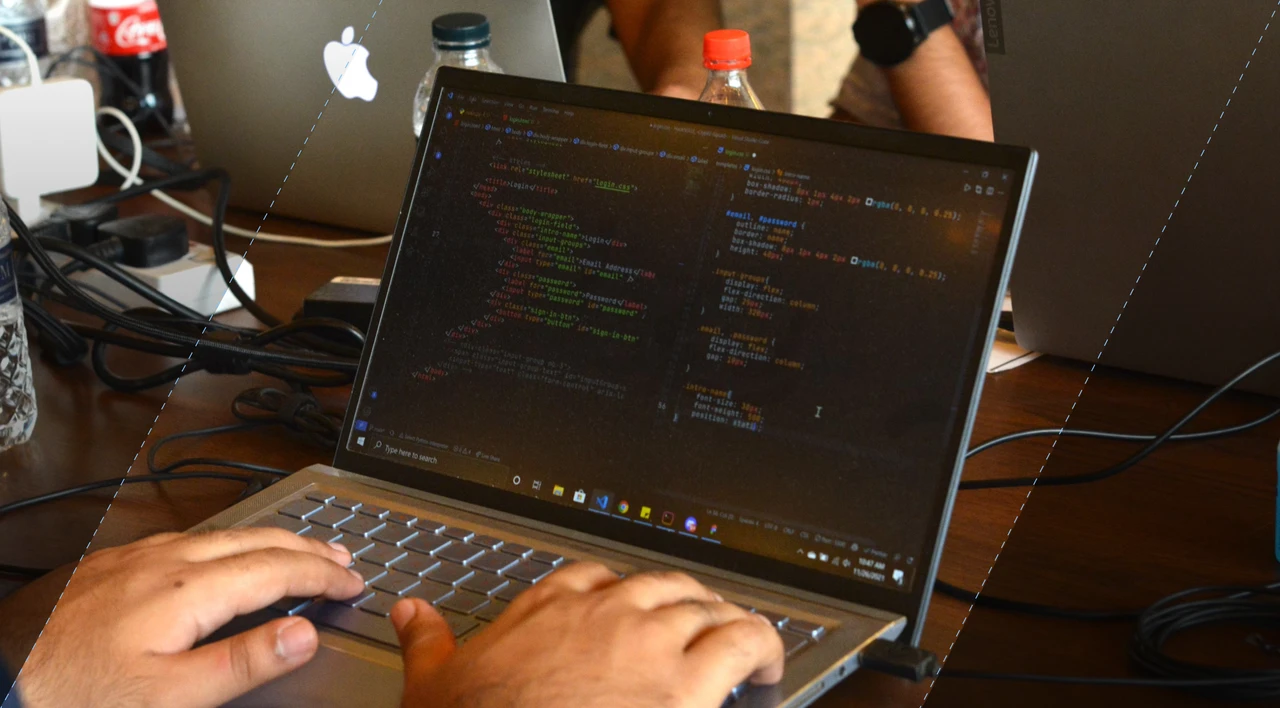SHARE
React Native MVP Development: Quick & Efficient

Contents
Contents
According to CB Insights, startups adopting the MVP methodology have a 30% higher likelihood of achieving success. Are you looking to build your minimum viable product (MVP) quickly and efficiently? With its seamless user experience, cost-effectiveness, and rapid development speed, React Native is the perfect choice for MVP development. Whether you’re a startup on a tight budget or an established company looking to validate a new product idea, React Native offers numerous advantages that can help you build, launch, and iterate your MVP successfully.
Key Takeaways:
- React Native is a powerful framework for MVP development.
- It allows you to build and launch your MVP quickly and efficiently.
- React Native offers a seamless user experience and native-like performance.
- By leveraging React Native’s architecture, you can save time and resources.
- Hiring experienced React Native developers can contribute to the success of your MVP.
Understanding React Native for MVP Development
React Native is an open-source framework developed by Facebook that revolutionizes the process of building native mobile apps. Powered by JavaScript, React Native allows developers to create powerful and feature-rich applications for both iOS and Android platforms with ease.
One of React Native’s key strengths is its component-based UI architecture. Instead of using web views or hybrid app development, React Native renders UI components as native widgets, ensuring optimal performance and a seamless user experience.
Through React Native development services, you can tap into its vast potential for MVP (Minimum Viable Product) development. With React Native, you can rapidly prototype and iterate your app idea to quickly validate its market viability. Building an MVP with React Native allows you to leverage its extensive library of pre-built components, saving development time and effort.
The React Native framework enables developers to create cross-platform applications, reducing the need for separate development cycles for iOS and Android. This not only saves time but also ensures consistency in UI and functionality across different platforms.
Furthermore, React Native allows for the integration of native modules, enabling access to device-specific features and capabilities. This flexibility and adaptability make React Native an ideal choice for MVP development, as you can easily enhance your app’s functionality based on user feedback and market demands.
With React Native, you can harness the power of a well-established framework backed by a vibrant developer community. This ensures continuous support, updates, and improvements, making React Native a sustainable choice for long-term app development.
Advantages of Using React Native for MVP Development
When it comes to MVP development, using React Native can provide you with multiple advantages that will help you build a successful product. Let’s explore the key benefits:
- Faster Development Speed: React Native allows for faster development speed through features like hot reloading and code reusability. This means that changes made to the code are instantly reflected in the app, making the development process more efficient and time-saving.
- Cost-Effectiveness: By using React Native, you can build your MVP with a single codebase that can be deployed on multiple platforms. This eliminates the need to develop separate apps for iOS and Android, reducing development costs significantly.
- Seamless User Experience: React Native enables you to deliver a seamless user experience with native-like performance. The framework utilizes native components, making the app feel and perform just like a native application.
- Flexibility and Adaptability: React Native allows seamless integration of native modules, which means you can leverage existing native capabilities and resources. This flexibility and adaptability make it easier to enhance your MVP with additional features in the future.
|
Advantage |
Description |
|
Faster Development Speed |
React Native enables faster development through hot reloading and code reusability. |
|
Cost-Effectiveness |
Using a single codebase saves development costs for multiple platforms. |
|
Seamless User Experience |
React Native provides native-like performance, enhancing the user experience. |
|
Flexibility and Adaptability |
Integration of native modules allows for flexibility and future feature enhancements. |
Building an MVP with React Native: The Ultimate Guide
Building a Minimum Viable Product (MVP) with React Native is an effective and efficient way to bring your app idea to life. By leveraging the power of React Native development, you can create a functional prototype that showcases your app’s core features while minimizing development time and costs.
Here is a step-by-step guide to help you build your MVP with React Native:
1. Define Your Goals and Objectives
Start by clearly establishing your app’s purpose and vision. Identify your target audience, their pain points, and how your app can solve their problems. Set specific goals and objectives for your MVP to ensure a focused and successful development process.
2. Prioritize Key Features
Identify the essential features that you want to include in your MVP. Focus on the core functionalities that deliver the most value to your target users. By prioritizing these features, you can streamline your development process and launch your MVP faster.
3. Choose the Right React Native Developers
Collaborate with experienced and skilled React Native developers who can understand your project requirements and bring your app idea to life. A proficient development team will ensure the smooth and efficient development of your MVP, translating your vision into a fully functioning app.
4. Rapid Prototyping and Development
In the MVP development process, rapid prototyping is crucial. Create low-fidelity wireframes or mockups to visualize your app’s user interface and validate your design concepts. Develop the core functionalities and user flows in small iterations, allowing for quick feedback and improvements.
5. Gather User Feedback
Engage your target audience early on and gather feedback on your MVP. Conduct user testing sessions or surveys to understand their preferences, pain points, and suggestions for improvement. User feedback will provide valuable insights and help you refine your app’s features and user experience.
6. Iterate and Improve
Based on the user feedback, iterate and make necessary improvements to your MVP. Continuously refine and enhance your app’s usability, performance, and interface design. By prioritizing feedback-driven iterations, you can ensure that your MVP meets the needs and expectations of your target users.
Remember, understanding the mobile app development process and leveraging React Native’s capabilities are the lifeblood of a successful MVP. React Native enables you to scale your mobile app efficiently while providing a seamless user experience across multiple platforms. By following this guide, you can effectively build your MVP with React Native and set the foundation for future app growth.
Real-World Examples of React Native MVPs
React Native stands as a versatile framework that makes it possible to build cross-platform MVPs with ease. Multiple successful companies have recognized the power of React Native and utilized its capabilities to launch their MVPs, providing seamless user experiences. Let’s delve into some real-world examples of companies that have built their MVPs using React Native:
1. Shopify
Shopify, the renowned e-commerce platform, used React Native to develop its mobile app. By leveraging React Native’s features, Shopify was able to create a scalable and efficient MVP that allowed users to manage their online stores on both iOS and Android platforms seamlessly.
2. Doximity
Doximity, a popular medical network, utilized React Native to build its mobile app. By choosing React Native, Doximity was able to develop a feature-rich MVP that delivered real-time communication, secure messaging, and networking capabilities to medical professionals across multiple platforms, ensuring a consistent and user-friendly experience.
3. Airbnb
Airbnb, the global accommodation marketplace, turned to React Native for its mobile app development. React Native enabled Airbnb to create a native-like MVP that unified the user experience on iOS and Android platforms. By leveraging the power of React Native, Airbnb provided a seamless booking experience for its users, optimizing performance and minimizing development efforts.
4. Instagram
Instagram, the popular social media platform, chose React Native for its mobile app development. By embracing React Native, Instagram was able to build a feature-rich and visually appealing MVP that allowed users to navigate their feed, upload photos, and engage with their community seamlessly on both iOS and Android platforms.
|
Company |
App |
Platforms |
|
Shopify |
E-commerce platform |
iOS, Android |
|
Doximity |
Medical networking |
iOS, Android |
|
Airbnb |
Accommodation marketplace |
iOS, Android |
|
|
Social media platform |
iOS, Android |
Conclusion
In conclusion, React Native emerges as the ultimate choice for MVP development. Its quick development speed and cost-effectiveness make it an ideal framework for startups and entrepreneurs looking to validate their product ideas efficiently. With React Native, you can build and launch your MVP seamlessly, leveraging its powerful architecture and reaping the benefits it offers.
The seamless user experience provided by React Native ensures that your MVP feels and performs like a native app on multiple platforms. Its flexibility and adaptability allow for easy integration of native modules, enhancing the functionality of your MVP. By hiring experienced React Native developers, you can maximize the potential for a successful MVP.
Leveraging the power of React Native development enables you to build and launch your MVP with confidence. By choosing React Native for your MVP development, you can harness its capabilities to validate your product idea efficiently and drive success in the market. So, don’t hesitate to embrace React Native and launch your MVP today.
Frequently Asked Questions
What is React Native MVP development?
React Native MVP development refers to the process of building a Minimum Viable Product (MVP) using the React Native framework. This approach allows for quick and efficient development of native applications with key features for initial testing and validation.
Why should I consider using React Native for MVP development?
React Native offers advantages such as faster development cycles, hot reloading, and the ability to deliver a native-like experience. It is also a popular choice for MVPs due to its cross-platform capabilities and ability to leverage existing JavaScript skills.
How can I build an MVP with React Native?
You can build an MVP with React Native by leveraging its components, libraries, and tools to create a functional prototype with essential features. The framework’s flexibility and efficiency make it suitable for rapid MVP development.
What are the benefits of using React Native for MVP development?
Some benefits of using React Native for MVP development include faster time to market, cost-effectiveness, ability to iterate quickly, cross-platform compatibility, and access to a large community and ecosystem of resources.
What are the key features of React Native for MVP development?
React Native offers features such as hot reloading, code reusability, support for third-party plugins, and a rich set of components for building user interfaces. These features contribute to the efficiency and speed of MVP development.
How does React Native facilitate the development of native applications?
React Native enables the development of native applications by allowing developers to use JavaScript to build mobile app interfaces with native components. This approach combines the performance and look of native apps with the productivity of a JavaScript library.
What should I consider beyond the MVP phase in React Native development?
Beyond the MVP phase, you can continue to enhance your React Native app by adding additional features, optimizing performance, refining the user experience, and scaling the application based on user feedback and market demand.
When should I use React Native to develop an MVP in the first place?
React Native can be a suitable choice for developing an MVP when rapid prototyping, cross-platform compatibility, and leveraging existing JavaScript skills are needed, and the goal is to validate the core concept with a functional prototype.
What advantages does React Native offer for MVP app development?
React Native offers advantages such as quick development cycles, the ability to deliver a native-like experience, cross-platform compatibility, and access to a vast ecosystem of libraries and resources. These advantages can contribute to efficient MVP app development.
How can I ensure skilled and experienced development for my React Native MVP project?
You can ensure skilled and experienced development for your React Native MVP project by hiring developers with expertise in React Native, reviewing their previous projects and experience, and considering recommendations or referrals from trusted sources or networks in the development community.
React Native Development Experts
Flatirons Development provides React Native development services tailored for your business needs.
Get the CEO's Take
Handpicked tech insights and trends from our CEO.
React Native Development Experts
Flatirons Development provides React Native development services tailored for your business needs.
Get the CEO's Take
Handpicked tech insights and trends from our CEO.

Digital Product Development: Enhance Your Business Offerings
Flatirons
Sep 12, 2025
React SEO: Optimize Your React Apps for Search Engines
Flatirons
Sep 07, 2025
Will Software Engineers Be Replaced by AI?
Flatirons
Aug 31, 2025
Best Data Analytics Strategy for Business Growth
Flatirons
Aug 25, 2025
Ruby Case Statement: A Simplified Approach to Conditional Logic
Flatirons
Aug 19, 2025
Team Augmentation: Enhance Your Workforce Capabilities
Flatirons
Aug 13, 2025